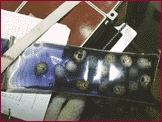



Objectives
Experiments studying the effects of space flight on embryo development in Japanese quail, conducted in 1990 and 1992 on Mir, revealed that embryonic development and hatching is possible during space flight. However, abnormalities were detected during various phases of embryo development. The presence of these abnormalities, and the decreased number of hatched eggs in comparison to a control group on Earth, provide information on the effects of space flight on embryogenesis. The exact nature of these effects are still unclear, and it is uncertain whether they are direct or indirect.
This investigation consisted of nine integrated experiments designed to study the effects of microgravity on the embryonic development of vertebrate animals (specifically quail), and the mechanisms by which abnormalities occur.
Shuttle-Mir Missions Approach
The experiment was performed on 1-G control and simulated flight embryos as well.
Results
Data also suggest that space flight does not significantly affect the development of the visuo-vestibular system in birds. The development of neurons in the brain, specifically the telencephalon, diencephalon and optic tectum of the mesencephalon, were not significantly different from that of the control embryos. Shape and size of the inner ear of flight embryos were also unchanged . However, the innervation patterns of afferent neurons in the inner ear were altered. Variables used to simulate flight on Earth were also found to retard the development of inner ear structures.
Limb size and bone formation were not apparently affected by development in microgravity. However, a reduction in mineralization was found at day 10, which by the 14th or 16th incubation day returned to normal values. The embryo's ability to uptake calcium from its shell was also impaired. Since synchronous control embryos had shell calcium levels that did not differ statistically from flight embryos, the higher than expected incubator temperature (40 ± 1 degree C) experienced on Mir was thought to be the cause.
A delay in the formation of blood vessels in the quail chorioallantoic membrane (CAM) and a possible impairment in the complexity of the microvascular network was found. Mechanical forces to which the eggs were exposed during the simulated launch also impeded the orderly development of blood vessels.
By the sixteenth day, control and flight embryos exhibited normal respiratory function (i.e., commencement of full breathing determined by histologically inflated lungs and no abnormalities in the alveolar cells).
Complete sexual and morphological development was accomplished. Histological data on the gonadal development of 3 day to 16 day old male and female flight embryos appeared normal. In addition, flight embryos appeared to develop at a faster rate than the control embryos, possibly due to the increased incubator temperature on Mir. The fact that a number of embryos developed normally is encouraging that a regenerative life support system can occur during space flight.
Publications Barrett, J.E., Wells, D.C., and Conrad, G.W. (abstract) ''Effects of microgravity on embryonic quail eye development.'' Am. Soc. Grav. Space Biol. Bull.: 12(1): 32 (1998).
Hester, P.Y., Orban, J.I., Piert, S.J., Gurieva, T., Wentworth, A.L., and Wentworth, B.C. (abstract) ''Effect of preflight activities and launch dynamics on avian embryogenesis.'' Am. Soc. Grav. Space Biol. Bull. (in press).
Orban, J.I. and Hester, P.Y. (abstract) ''Calcium uptake by quail embryos incubated in space.'' Am. Soc. Grav. Space Biol. Bull. (in press).
Principal Investigators
Gary W. Conrad, Ph.D.
Stephen B. Doty, Ph.D.
Cesar D. Fermin, Ph.D.
Bernd Fritzsch, Ph.D.
Patricia Hester, Ph.D.
Peter I. Lelkes, Ph.D.
Toru Shimizu, Ph.D.
Bernard C. Wentworth, Ph.D. Co-Investigators![]()
Mir-18, Mir 19, NASA-2
Forty-eight fertile Japanese quail eggs were sent to Mir on the Space Shuttle for the NASA-2 mission. The eggs were kept at a constant warm temperature on Mir in an incubator specially designed for microgravity, which allowed the eggs to continue developing. The eggs were removed from incubation during various stages of growth and development at 7, 10, 13 and 16 days (quail hatch at 17 days). After removal from the incubator, the eggs were placed in a fixative solution to preserve them for later analysis on Earth. Researchers performed postflight analyses on the fixed embryos to determine how microgravity affected quail egg development, specifically development of the visuo-vestibular system, bone formation and mineralization, blood vessel formation, respiratory function and sexual development.
When data from flight and control embryos were statistically analyzed, no significant differences were found between flight and control embryos for eyeball measurements (weight and diameter). However, a difference in the corneal diameter was observed.
Barrett, J.E., Wells, D.C., and Conrad, G.W. (abstract) ''Effects of microgravity on embryonic quail eye development.'' Invest. Ophthalmol. Vis. Sci. 39 (4): S1037 (poster #4790-B541) (1998).
Page A. W. Anderson, M.D.
Duke University Medical Center
Kansas State University
Hospital for Special Surgery
Tulane University School of Medicine
Creighton University
Purdue University
University of Wisconsin Medical School
University of South Florida
University of Wisconsin
Joyce E. Barrett, Ph.D.
Laura Bruce, Ph.D.
Guilin Lu, Ph.D.
Joseph I. Organ, Ph.D.
Brian R. Unsworth, Ph.D.
Diane C. Wells
Alice L. Wentworth, M.S.
![]()
|
|
Curator:
Julie Oliveaux
Responsible NASA Official: John Uri |
Page last updated: 07/16/1999
.gif)